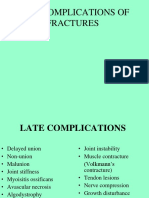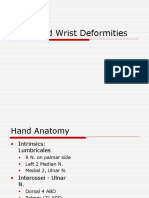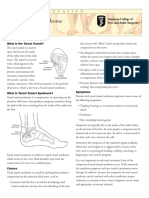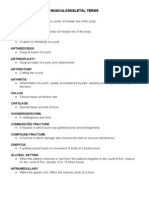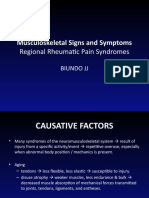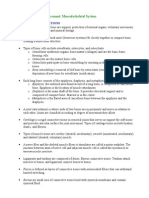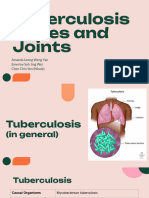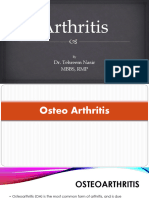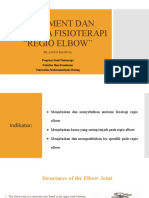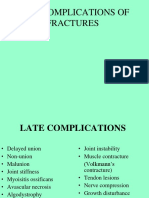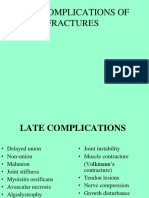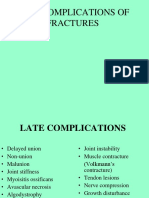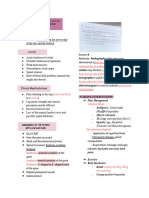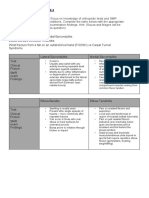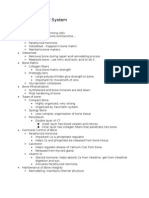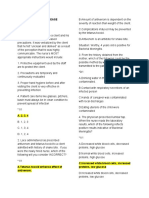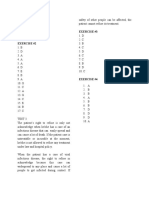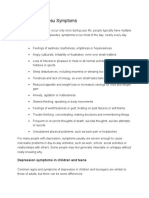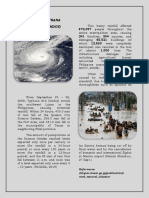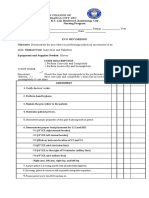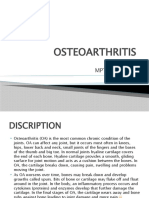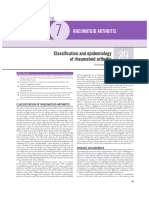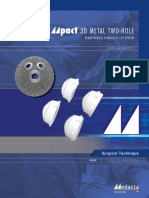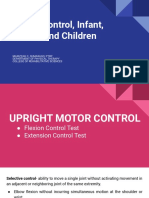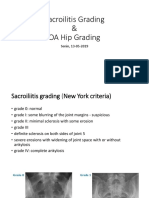0 ratings0% found this document useful (0 votes)
27 viewsPrecipitating Factors
Precipitating Factors
Uploaded by
Cake ManThis document summarizes several common orthopedic conditions:
1. Bursitis, carpal tunnel syndrome, loose bodies, Dupuytren's disease, Achilles tendinitis, plantar fasciitis are discussed including their causes, signs/symptoms, and management approaches.
2. Carpal tunnel syndrome results from repetitive wrist movement and presents with pain, numbness, and weakness relieved by surgery if conservative measures fail. Bursitis causes pain around joints that is managed with rest, anti-inflammatories, and sometimes surgery.
3. Plantar fasciitis presents as heel pain that improves with walking and is managed with stretching exercises. Achilles tendinitis from overuse
Copyright:
© All Rights Reserved
Available Formats
Download as DOCX, PDF, TXT or read online from Scribd
Precipitating Factors
Precipitating Factors
Uploaded by
Cake Man0 ratings0% found this document useful (0 votes)
27 views2 pagesThis document summarizes several common orthopedic conditions:
1. Bursitis, carpal tunnel syndrome, loose bodies, Dupuytren's disease, Achilles tendinitis, plantar fasciitis are discussed including their causes, signs/symptoms, and management approaches.
2. Carpal tunnel syndrome results from repetitive wrist movement and presents with pain, numbness, and weakness relieved by surgery if conservative measures fail. Bursitis causes pain around joints that is managed with rest, anti-inflammatories, and sometimes surgery.
3. Plantar fasciitis presents as heel pain that improves with walking and is managed with stretching exercises. Achilles tendinitis from overuse
Original Title
Bursitis
Copyright
© © All Rights Reserved
Available Formats
DOCX, PDF, TXT or read online from Scribd
Share this document
Did you find this document useful?
Is this content inappropriate?
This document summarizes several common orthopedic conditions:
1. Bursitis, carpal tunnel syndrome, loose bodies, Dupuytren's disease, Achilles tendinitis, plantar fasciitis are discussed including their causes, signs/symptoms, and management approaches.
2. Carpal tunnel syndrome results from repetitive wrist movement and presents with pain, numbness, and weakness relieved by surgery if conservative measures fail. Bursitis causes pain around joints that is managed with rest, anti-inflammatories, and sometimes surgery.
3. Plantar fasciitis presents as heel pain that improves with walking and is managed with stretching exercises. Achilles tendinitis from overuse
Copyright:
© All Rights Reserved
Available Formats
Download as DOCX, PDF, TXT or read online from Scribd
Download as docx, pdf, or txt
0 ratings0% found this document useful (0 votes)
27 views2 pagesPrecipitating Factors
Precipitating Factors
Uploaded by
Cake ManThis document summarizes several common orthopedic conditions:
1. Bursitis, carpal tunnel syndrome, loose bodies, Dupuytren's disease, Achilles tendinitis, plantar fasciitis are discussed including their causes, signs/symptoms, and management approaches.
2. Carpal tunnel syndrome results from repetitive wrist movement and presents with pain, numbness, and weakness relieved by surgery if conservative measures fail. Bursitis causes pain around joints that is managed with rest, anti-inflammatories, and sometimes surgery.
3. Plantar fasciitis presents as heel pain that improves with walking and is managed with stretching exercises. Achilles tendinitis from overuse
Copyright:
© All Rights Reserved
Available Formats
Download as DOCX, PDF, TXT or read online from Scribd
Download as docx, pdf, or txt
You are on page 1of 2
Bursitis
Carpal Tunnel Syndrome
Is a condition that results when there is injury to Precipitating factors:
the bursa that commonly occurs with reduced
friction between tendons, bones and ligaments • Repetitive hand and wrist movement
• Exposure to cold temperature
Bursae - are fluid-filled sacs that are lined with • Excessive vibrations in the hand and wrist
synovium similar to the lining of the joint • Carpal Tunnel Syndrome
surfaces
Manifestations:
Bursitis versus Synovitis
• Pain especially at night
• Bursitis is inflammation of the sac between the tendon • Numbness
and an adjacent bone that the tendon glides over, the sac • Paresthesia
is lined with a membrane that produces synovial fluid. • Weakness along the median nerve
TINEL's sign indicates CTS
• Synovitis refers to inflammation that occurs in the
tendon sheath (tenosynovitis) or the inner lining of the Management:
joint capsule (synovitis)
Bursitis 1. Medical
• Is based on the cause
Signs and Symptoms: • Use of wrist splints to prevent hyperextension and
prolonged flexion
• Pain around joint - commonly the shoulder,
knee, hip and elbow Advise to avoid repetitive hand and wrist movement
• Limited ROM
• Tenderness • NSAID's and cortisone injections
• Varying degrees of redness, warmth and • Others-yoga, acupuncture, etc.
swelling
2. Surgery is advised in severe cases:
Bursitis-Management
• Open nerve release
• R.I.C.E. • Endoscopic laser surgery
• NSAID's and analgesic
• ROM exercises • Open Release for Carpal Tunnel Syndrome
• Intra articular corticosteroid injections
• Surgery - when calcified deposits or adhesions
have diminished the function of the affected part
Ganglion
Loose bodies
• A collection of gelatinous material near the
• Small pieces of bone or cartilage floating within tendon sheaths and joints
a joint capsule. • Appears as a round, firm, cystic swelling.
• may include pieces of articular cartilage.
• probably reflects a joint trauma or the wearing • Ganglia can form around any joint, but they are
away of the articular cartilage that exposes the most frequently found in the wrist and ankles.
surface of the bone beneath, causing it to die and
separate. They are usually painless and often barely visible as
localized swellings. They typically do not appear to
Loose Bodies-Manifestations be inflamed unless they are big
• painful catching or locking of the joint. Ganglion
• Limited ROM
• Abnormal gait • Common in women who are in their 50's
• Pain may or may not be present
• Loose bodies may promote osteoarthritis if they • Weakness of the fingers occur with tendon sheath
are not removed or reattached in time. involvement
Loose Bodies Management involves aspiration, corticosteroid
injection or surgical incision
• X-ray, ultrasound, CT scan, or MRI, help find a
loose body. Dupuytren's disease
• Surgery (usually by arthroscopy) to remove the
loose body or repair the kneecap may be needed • A condition characterized by progressive contracture of
if a loose body is causing symptoms the palmar fascia that causes flexion of the fourth and
fifth fingers, most frequently, the middle finger.
Carpal Tunnel Syndrome
In severe cases, the affected fingers lose function
• An entrapment neuropathy that occurs when the
nerve at the wrist is compressed by a thickened Dupuytren's disease
flexor tendon sheath, skeletal encroachment,
edema or soft tissue mass. • Is caused by inherited autosomal trait
• Tarsal Tunnel - foot
• Occurs frequently in men • Shoes with support
• Heel cups and other orthotic devices
• Occurs frequently to those >50 years • NSAID's
• Associated with arthritis, DM, Gout alcoholism.
Stars as nodule in the palmar fascia, which may or may
not progress so the fibrous thickening extends to involve
the skin in the distal palm and produces a contracture of
the fingers.
Clinical manifestations include dull aching discomfort,
morning numbness,
In the affected fingers. Starts in one hand but eventually
become bilateral cramping and stiffness
Initially, finger stretching exercises can prevent
contractures. Fasciectomies are performed of the palm
and digits to improve function. Finger exercises may
begin in 1-2 post op days.
Achilles Tendonitis/ Tendinitis
• Overuse of the Achilles tendon can cause
inflammation that can lead to pain and swelling.
• Patients tend to experience pain after first
walking in the morning and when getting up
after sitting for long periods of time.
• Patients will also experience pain while
participating in activities, such as when running
or jumping.
Tendonitis
• X-ray is not usually diagnostic but can be used
• Thompson's test helps in the diagnosis of Achilles
rupture.
Thompson's Test
• ✓Patient kneels on the chair or less prone while
examiner squeezes affected calf
• ✓Normally, the foot responds by moving
downward
Tendonitis-Management
• R.I.C.E
• Splinting or casting for up to 6 weeks in
functional position occurs
• Surgical intervention if rupture
• Physical therapy is required for rehabilitation
• Health teaching - advise not to return to full
activity until strength is equal to unaffected
extremity
Plantar Fasciitis
• is inflammation of the fascia that runs along the
bottom of the foot from the heel to the toes
• As the fascia is stretched, microscopic tears
develop at the point where the fascia attaches to
the calcaneous
Plantar Fasciitis
• Pain is localized at the anterior medial aspect of the
heel and diminishes with walking
Management includes:
• Stretching exercises
You might also like
- Catch 22 AnnotationsDocument38 pagesCatch 22 Annotationsapi-612111323No ratings yet
- Malunion Delayed Union and Nonunion FracturesDocument31 pagesMalunion Delayed Union and Nonunion FracturesAzmi FarhadiNo ratings yet
- Bursitis-Tendonitis-Dr - Amit PatelDocument52 pagesBursitis-Tendonitis-Dr - Amit PatelAmitNo ratings yet
- TenosynovitisDocument48 pagesTenosynovitisbajajmetals08No ratings yet
- Neuromusculosklatal Disorders FK UnayaDocument62 pagesNeuromusculosklatal Disorders FK UnayaSuci MayveraNo ratings yet
- Regional Conditions of WristDocument54 pagesRegional Conditions of WristSreekar ReddyNo ratings yet
- Wrist and Finger SeminarDocument40 pagesWrist and Finger SeminarMisoNo ratings yet
- Tarsal Tunnel SyndromeDocument2 pagesTarsal Tunnel Syndromeannisa shezanNo ratings yet
- Ism 2023 Final Product PapersDocument7 pagesIsm 2023 Final Product PapersMahnoor MemonNo ratings yet
- Talus FracturesDocument19 pagesTalus Fracturessundar persaudNo ratings yet
- MUSCULOSKELETALTERMSDocument3 pagesMUSCULOSKELETALTERMSapi-3822433No ratings yet
- Abnormalities of Bones and JointsDocument47 pagesAbnormalities of Bones and JointsAndrew KaumbaNo ratings yet
- Diabetic FootDocument21 pagesDiabetic Foothacker ammerNo ratings yet
- Enthesopathy: Dr. Jufri Latief, SP.B., SP - OTDocument43 pagesEnthesopathy: Dr. Jufri Latief, SP.B., SP - OTraraslyNo ratings yet
- Complications of FracturesDocument55 pagesComplications of FracturesMina SamirNo ratings yet
- Carpal Tunnel SyndromeDocument11 pagesCarpal Tunnel SyndromedopsevofyaNo ratings yet
- Group 24 - Knee PainDocument8 pagesGroup 24 - Knee PainDr.Rathod RanjithNo ratings yet
- 3D Regional Rheumatic PainDocument50 pages3D Regional Rheumatic PainIkhsan Amadea9969No ratings yet
- Ra of The HipDocument34 pagesRa of The HipSusie Rae FajardoNo ratings yet
- Knee&Foot Part1Document28 pagesKnee&Foot Part1SarkawtNo ratings yet
- Orthopedics PDFDocument14 pagesOrthopedics PDFSam christenNo ratings yet
- Achilles TendinitisDocument10 pagesAchilles TendinitisS MediaNo ratings yet
- Mohd Afiq Izzuddin Bin Rossli (1001336000) (Soft Tissue Swelling) 543. 15-16Document23 pagesMohd Afiq Izzuddin Bin Rossli (1001336000) (Soft Tissue Swelling) 543. 15-16Star CruiseNo ratings yet
- MS 36Document7 pagesMS 36jefrocNo ratings yet
- Muscle Injuries and Basic RemediesDocument28 pagesMuscle Injuries and Basic Remediesvtay05No ratings yet
- Leprosy: BY:-Sweta Upadhyay BPT 4 YearDocument29 pagesLeprosy: BY:-Sweta Upadhyay BPT 4 YearSweta upadhyayNo ratings yet
- Approach To Bone MalignancyDocument38 pagesApproach To Bone MalignancyAna S.NazrulNo ratings yet
- Facture/Dislocation: R I C EDocument23 pagesFacture/Dislocation: R I C EKrishnamurti KambleNo ratings yet
- Angela Hand and Upper ExtremityDocument59 pagesAngela Hand and Upper ExtremityJenny RajanNo ratings yet
- 4 Shoulder JointDocument50 pages4 Shoulder Jointq77gkyhzs4No ratings yet
- Symptoms End Signs of Musculoskeletal SystemDocument70 pagesSymptoms End Signs of Musculoskeletal SystemErde NmuNo ratings yet
- Peripheral Nerve Disorders (Dr. Ken)Document72 pagesPeripheral Nerve Disorders (Dr. Ken)Nurindha Shimelia M ZNo ratings yet
- Trigger Finger and Ganglion Cyct - Seminar Ortho Year 5Document63 pagesTrigger Finger and Ganglion Cyct - Seminar Ortho Year 5Sh Zahra100% (1)
- 68 DISEASES 2nd Semsester 3rd Year 1 PDFDocument117 pages68 DISEASES 2nd Semsester 3rd Year 1 PDFJimlord GarciaNo ratings yet
- Contractures WPS OfficeDocument14 pagesContractures WPS OfficeMiss KayaniNo ratings yet
- Treating WristDocument71 pagesTreating WristSyahriadin SyamNo ratings yet
- Myositis OssificansDocument20 pagesMyositis OssificanssarathNo ratings yet
- TB Bones and JointsDocument83 pagesTB Bones and JointsAlex XanderNo ratings yet
- Dr. Tehreem Nasir MBBS, RMPDocument32 pagesDr. Tehreem Nasir MBBS, RMPAhmed SaeedNo ratings yet
- AnD FT Elbow-1Document26 pagesAnD FT Elbow-1Nazwa KamilatunnisaNo ratings yet
- Chapter 18 Vocab: Condyle Articular Cartilage Medial Meniscus Lateral Meniscus Anterior Cruciate Ligament (ACL)Document4 pagesChapter 18 Vocab: Condyle Articular Cartilage Medial Meniscus Lateral Meniscus Anterior Cruciate Ligament (ACL)mph440No ratings yet
- MedSurg Chapter 51 OutlineDocument7 pagesMedSurg Chapter 51 OutlineJosephine Navarro100% (1)
- Oa RaDocument24 pagesOa RaRehab NaeemNo ratings yet
- Wrist and HandDocument21 pagesWrist and HandsadiaNo ratings yet
- Malunion Delayed Union and Nonunion FracturesDocument31 pagesMalunion Delayed Union and Nonunion FracturesKalayo100% (1)
- Malunion Delayed Union and Nonunion FracturesDocument31 pagesMalunion Delayed Union and Nonunion FracturesutisuryanjNo ratings yet
- Malunion Delayed Union and Nonunion FracturesDocument31 pagesMalunion Delayed Union and Nonunion FracturesRasjad ChairuddinNo ratings yet
- Malunion Delayed Union and Nonunion FracturesDocument31 pagesMalunion Delayed Union and Nonunion Fracturessatya yudhayanaNo ratings yet
- Pe of The Joint - GoutDocument50 pagesPe of The Joint - GoutCharisse Ann GasatayaNo ratings yet
- TenosynovitisDocument14 pagesTenosynovitisHimasree SagarikaNo ratings yet
- Carpel Tunnel Syndrome IDocument2 pagesCarpel Tunnel Syndrome Iapi-3822433No ratings yet
- Tuberculosis in Orthopaedics: DR - Rohit Final Year PG OrthopaedicsDocument45 pagesTuberculosis in Orthopaedics: DR - Rohit Final Year PG OrthopaedicsManda100% (1)
- Chapter 36 - Musculoskeletal DisordersDocument5 pagesChapter 36 - Musculoskeletal Disordersvenezuelatrishamae22No ratings yet
- Week 8 QuestionsDocument8 pagesWeek 8 Questionsapi-479716004No ratings yet
- Musculoskeletal SystemDocument6 pagesMusculoskeletal SystemsimonedarlingNo ratings yet
- Tubercular ArthritisDocument37 pagesTubercular Arthritis2968hcmtjnNo ratings yet
- ARTHRITISDocument56 pagesARTHRITISomarmamluky254No ratings yet
- Ingrown Toenail (Onychocryptosis)Document18 pagesIngrown Toenail (Onychocryptosis)Ray Yankees100% (1)
- Ankylosing SpondylitisDocument41 pagesAnkylosing SpondylitisAaliyah ShaikhNo ratings yet
- Rheumatology ElMenawy 2021Document481 pagesRheumatology ElMenawy 2021malikNo ratings yet
- FC - CDDocument27 pagesFC - CDCake ManNo ratings yet
- Module PrelimDocument5 pagesModule PrelimCake ManNo ratings yet
- No Pregnancy Is Safe For Any WomanDocument2 pagesNo Pregnancy Is Safe For Any WomanCake ManNo ratings yet
- Final Coaching - PalmrDocument55 pagesFinal Coaching - PalmrCake ManNo ratings yet
- 2 AspectsDocument4 pages2 AspectsCake ManNo ratings yet
- Related Lit Case StudyDocument3 pagesRelated Lit Case StudyCake ManNo ratings yet
- Depressusion Desu SymptomsDocument3 pagesDepressusion Desu SymptomsCake ManNo ratings yet
- Typoon KetsanaDocument2 pagesTypoon KetsanaCake ManNo ratings yet
- The CardiacDocument7 pagesThe CardiacCake ManNo ratings yet
- Tuti, Rhidab. (Transculture)Document1 pageTuti, Rhidab. (Transculture)Cake ManNo ratings yet
- NASO and ORO-Tracheal SuctioningDocument4 pagesNASO and ORO-Tracheal SuctioningCake ManNo ratings yet
- Activity 1. EssayDocument4 pagesActivity 1. EssayCake ManNo ratings yet
- Assessment 2 1 0 CommentDocument2 pagesAssessment 2 1 0 CommentCake ManNo ratings yet
- What Is Gastritis?Document13 pagesWhat Is Gastritis?Cake ManNo ratings yet
- Checklist For Cardiac AssessmentDocument3 pagesChecklist For Cardiac AssessmentCake ManNo ratings yet
- Meniscus Injury: Presented by Siti Nur Rifhan KamarudinDocument29 pagesMeniscus Injury: Presented by Siti Nur Rifhan KamarudindrynwhylNo ratings yet
- Arthroscopic Wrist AnatomyDocument8 pagesArthroscopic Wrist AnatomyLaineyNo ratings yet
- Locomotory ExaminationDocument32 pagesLocomotory ExaminationAditya AnandNo ratings yet
- OsteoarthritisDocument23 pagesOsteoarthritisGoutham VGouthamNo ratings yet
- Walking AidsDocument38 pagesWalking AidsMurad KurdiNo ratings yet
- ORTHO by Target 200 PlusDocument21 pagesORTHO by Target 200 PlusTMC PGI GENER MICKONo ratings yet
- Anatomy of The AntebrachiiDocument20 pagesAnatomy of The AntebrachiiIrfan Suryo RakhmattoNo ratings yet
- ArtritisDocument131 pagesArtritisricharddocumNo ratings yet
- Mpact 3D Metal Two-Hole - BrochureDocument20 pagesMpact 3D Metal Two-Hole - Brochuremaelained4No ratings yet
- Topic 14 PT 201 - Upright Motor Control, Infant, Toddler and ChildrenDocument50 pagesTopic 14 PT 201 - Upright Motor Control, Infant, Toddler and ChildrenEJ GejonNo ratings yet
- Daftar Diagnosis Dan Tindakan Orthopaedi Ina CBG Baru Dan Plafonb - CompressDocument11 pagesDaftar Diagnosis Dan Tindakan Orthopaedi Ina CBG Baru Dan Plafonb - CompressChika HardiyantiNo ratings yet
- R DOC PRD 190316071 PDFDocument2 pagesR DOC PRD 190316071 PDFRafic AbdallahNo ratings yet
- Musculoskeletal System: Health AssessmentDocument43 pagesMusculoskeletal System: Health AssessmentEliezer Nuenay100% (1)
- Patterns of Premature Physeal Arrest:: MR Imaging of 111 ChildrenDocument6 pagesPatterns of Premature Physeal Arrest:: MR Imaging of 111 Childrenjose pablo reyes ortizNo ratings yet
- Sens-And-Specif-Chart 1Document3 pagesSens-And-Specif-Chart 1api-479499469No ratings yet
- Conformation and Soundness: Colorado State University, Fort Collins, Colorado USADocument5 pagesConformation and Soundness: Colorado State University, Fort Collins, Colorado USAJonathan LiNo ratings yet
- Talus PartitusDocument11 pagesTalus PartitusLuciano AlvesNo ratings yet
- Knee Pain Location Chart - The Chelsea Knee ClinicDocument10 pagesKnee Pain Location Chart - The Chelsea Knee ClinicpapNo ratings yet
- 480E Knee CPMDocument2 pages480E Knee CPMMohamed TalaatNo ratings yet
- Prosthetic Gait DeviationsDocument24 pagesProsthetic Gait Deviationsiqra jabeenNo ratings yet
- Ankle FracturesDocument59 pagesAnkle FracturesMabvuto BandaNo ratings yet
- Diagnostic and Therapeutic Injection of The Ankle and Foot 1Document7 pagesDiagnostic and Therapeutic Injection of The Ankle and Foot 1B.No ratings yet
- Giles - A2 ReviewerDocument27 pagesGiles - A2 ReviewerCatrina TanNo ratings yet
- Sas 33Document3 pagesSas 33Sistine Rose LabajoNo ratings yet
- MSK Lab ManualDocument67 pagesMSK Lab ManualSyed Talha HussainNo ratings yet
- Chrissa Mae T. Catindoy BS Medical Technology 3A: Group Classification Pathologic SignificanceDocument5 pagesChrissa Mae T. Catindoy BS Medical Technology 3A: Group Classification Pathologic SignificanceChrissa Mae Tumaliuan CatindoyNo ratings yet
- Sacroilitis GradingDocument14 pagesSacroilitis GradingBelinda KoesmarsonoNo ratings yet
- Initial Evaluation General InformationDocument10 pagesInitial Evaluation General InformationANAS TALAL ALI AltammarNo ratings yet
- Vestige Collagen LaunchDocument12 pagesVestige Collagen Launchmadhan4music100% (1)

